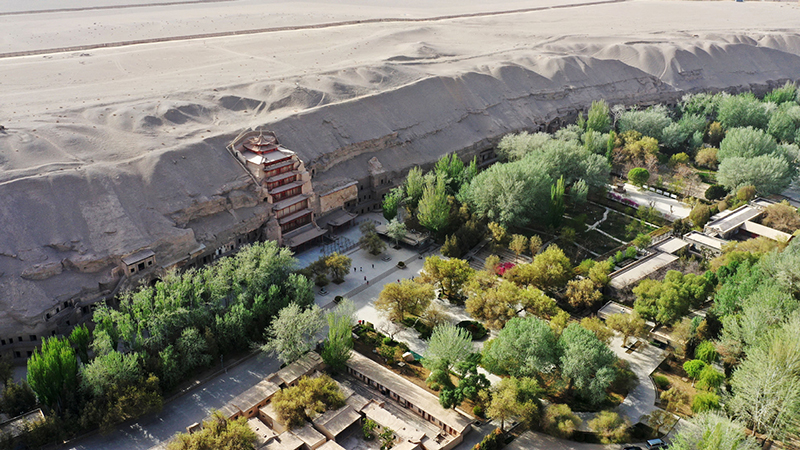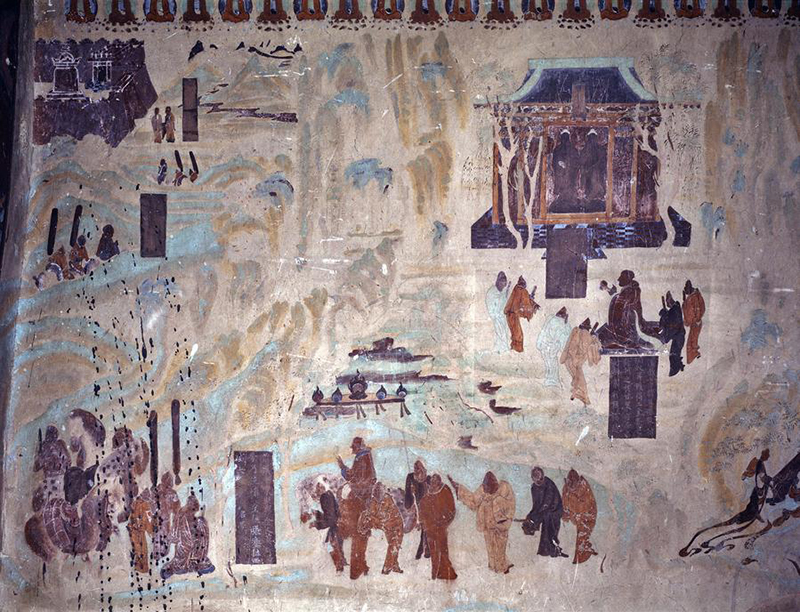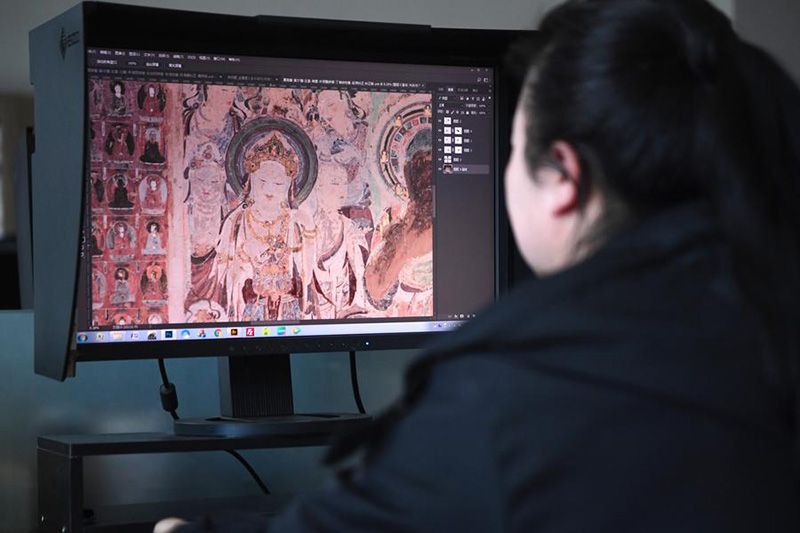
BEIJING, Jan. 29 -- Lying in an oasis at the edge of the Taklamakan Desert, Dunhuang was a major stop on the ancient Silk Road, which linked the East and West through vibrant trade.
The distinctive culture of Dunhuang is best represented by the Mogao Grottoes, designated a UNESCO World Heritage Site. Dating back to the 4th century, the site features 735 caves carved into a cliff, currently housing more than 2,000 colorful sculptures and 45,000 square meters of murals.
This extraordinary cultural treasure helps draw visitors to the historical city -- including Chinese President Xi Jinping.
In August 2019, during an inspection tour in Gansu, the president set aside time for his first visit to the millennium-old grottoes, thus realizing a long-cherished wish.
Xi, also general secretary of the Communist Party of China Central Committee and chairman of the Central Military Commission, has paid much attention to the protection of cultural relics in Dunhuang over the years, and to the development of Dunhuang's culture.
A FAN OF DUNHUANG
During his 2019 tour, Xi made the Mogao Grottoes his first stop. He was particularly captivated by a mural in Mogao Cave 323, recognizing the character of Zhang Qian, an envoy in the Han Dynasty (202 B.C.-220 A.D.).
Though it was the first time Xi had visited the Mogao Grottoes, he was already very familiar with the cultural relics there, thanks to his long-standing emotional attachment to the site.
As early as 1986, Xi visited Gansu when he was serving as deputy mayor of the coastal city of Xiamen, Fujian Province, but he was unable to go to Dunhuang at the time due to a tight schedule and the long distance to the site. Over 30 years later, he still talks of his regret at not making the journey back then.
During an academic discussion as part of a research trip at Zhejiang University in 2005, Xi, then Party secretary of Zhejiang Province, recited a list of the achievements of renowned Dunhuang expert Jiang Liangfu.
In 2009, when conducting research as a state leader at Lanzhou University in Gansu, Xi encouraged Zheng Binglin, director of the university's Dunhuang Studies Institute, to strengthen and expand the development of Dunhuang studies as a contribution to the country.

Xi has on multiple occasions stressed the value of Dunhuang, calling it "an important historical hub" of Eastern and Western cultures, and one of the "living monuments" to past interactions between different civilizations on the ancient Silk Road.
For Xi, the significance of Dunhuang goes beyond its history, with efforts underway to revive and expand cooperation along and beyond the ancient Silk Road routes.
Back in 2013, Xi proposed the construction of the Silk Road Economic Belt and the 21st Century Maritime Silk Road, also known as the Belt and Road Initiative (BRI), which has been welcomed by the international community as a public good and cooperation platform.
"As we are now advancing Belt and Road cooperation, we came back to draw inspiration from the ancient Silk Road," Xi said during his 2019 visit to the caves.
A PRESERVER OF DUNHUANG
In September 2019, at a ceremony in Beijing, Xi presented the national honorary title of outstanding contributor to cultural-relic protection to Fan Jinshi, an archaeologist who has made a lifelong career of protecting and studying the cultural relics of the Mogao Grottoes.
While shaking hands with Fan, Xi asked her about the rainfall in Dunhuang.
Over a month ago, at a symposium held during Xi's visit to Dunhuang, Fan discussed with Xi a series of natural factors that could affect the preservation of Dunhuang's cultural relics, including water.
At the meeting, Xi inquired about issues ranging from the number of tourists to the impact of natural disasters. "The protection of world cultural heritage should be placed above tourism as our top priority. We should not set our eyes solely on selling tickets and pursuing economic benefits," he stressed.
"What concerns Xi are the most pressing challenges facing Dunhuang today," Fan said.
Through decades of hard work, substantial progress has been made in safeguarding the site's priceless treasures, particularly through the use of advanced technologies.
In 2020, a leading laboratory was launched to study the weathering mechanism of the caves, simulating diverse natural environments for targeted protection measures.
A SUPPORTER OF DUNHUANG CULTURE
Xi's Mogao Grottoes tour took him to the Library Cave, where around 60,000 rare cultural relics were unearthed. However, about 40,000 pieces have been lost to more than 10 countries, including Britain, France, Russia and Japan.
"Only when the country is strong can its culture prosper," Xi said, reminiscing on how the Library Cave was discovered in 1900, a time when the country was too weak to safeguard its cultural relics.

Xi has encouraged the Dunhuang Academy to share its cultural and artistic resources digitally on a global scale.
In April 2023, a virtual duplication of the Library Cave became accessible to the public through an interactive digital platform.
The platform uses advanced digital technology to reproduce historical scenes of the Library Cave. It invites visitors to immerse themselves in the culture of Dunhuang by engaging in role-play and "time travel" to ancient dynasties.
Two days after his visit to Mogao Grottoes, when inspecting a publishing company in Lanzhou, the capital city of Gansu Province, Xi again raised the topic of Dunhuang.
"Xi noted that the Dunhuang manuscripts are rich in content, serving as valuable historical records," recalled Fu Kangnian, the company's deputy general manager.
In response to Xi's call to better utilize historical resources, a significant number of books related to Dunhuang and the Jiandu -- bamboo or wooden slips that ancient Chinese people wrote on before the invention of paper -- have been published in recent years.
A compilation book series on Dunhuang history was published, after years of hard work, filling gaps in historical records and providing points of reference for Dunhuang studies.
Even more remarkable is that the conservation efforts applied to the Dunhuang culture have extended beyond the local boundaries. The ideas and technologies employed to protect the caves have been applied to more than 500 national-level cultural relics protection projects, and introduced to BRI partner countries.